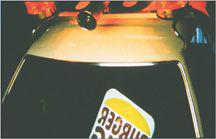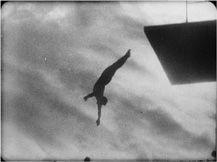Authors: David Bordwell,Kristin Thompson
B0041VYHGW EBOK (142 page)
Very often a documentary pursues several of these options at once. A film may mix archival footage, interviews, and material shot on the fly, as do
Fahrenheit 9/11, The Fog of War,
and
In the Year of the Pig.
This
synthetic
documentary format is also common in television journalism.
In contrast to a documentary, with a fictional film, we assume that it presents imaginary beings, places, or events. We take it for granted that Don Vito Corleone and his family never existed, and that their activities, as depicted in
The Godfather,
never took place. Bambi’s mother did not really get shot by a hunter because Bambi, his mother, and their forest companions are imaginary.
If a film is fictional, that doesn’t mean that it’s completely unrelated to actuality. For one thing, not everything shown or implied by a fiction film need be imaginary.
The Godfather
alludes to World War II and the building of Las Vegas, both historical events; it takes place in New York City and in Sicily, both real locales. Nonetheless, the characters and their activities remain fictional, with history and geography providing a context for the made-up elements.
Fictional films are tied to actuality in another way: they often comment on the real world.
Dave,
about an imaginary U.S. president and his corrupt administration, criticizes contemporary political conduct. In 1943, some viewers took Carl Dreyer’s
Day of Wrath,
a film about witch-hunts and prejudice in 17th-century Denmark, as a covert protest against the Nazis currently occupying the country. Through theme, subject, characterization, and other means, a fictional film can directly or obliquely present ideas about the world outside the film.
CONNECT TO THE BLOG
For a discussion of how animation can be used in documentaries, see “Showing what can’t be filmed,” at
www.davidbordwell.net/blog/?p=3837
.
Sometimes our response to a fictional film is shaped by our assumptions about how it was made. The typical fictional film stages all or nearly all its events; they are designed, planned, rehearsed, filmed, and refilmed. The studio mode of production is well suited to creating fiction films, since it allows stories to be scripted and action to be staged until what is captured on film satisfies the decision makers. Similarly, in a fictional film, the characters are portrayed by actors, not photographed directly (as in a documentary). The camera films not Vito Corleone but Marlon Brando portraying the Don.
This assumption about how the film was made typically comes into play when we consider historical films or biographies.
Apollo 13
and
Schindler’s List
base themselves on actual events, while
Malcolm X, Walk the Line, W.,
and other
biopics
trace episodes in the lives of people who really existed. Are these documentaries or fictional films? In practice, most such films add purely make-believe characters, speeches, or actions. But even if the films did not tamper with the record in this way, they would remain fictional according to our assumptions about how they were produced. Their events are wholly staged, and the historical agents are portrayed through actors’ performances. Just as important, the films don’t purport to be documentaries. They are presented as historical re-creations. Like plays or novels based on real-life events, historical and biographical movies convey ideas about history by means of fictional portrayal.
As you might expect, filmmakers have sometimes sought to blur the lines separating documentary and fiction. A notorious example is Mitchell Block’s
No Lies,
which purports to present an interview with a woman who has been raped. Audiences are typically disturbed by the woman’s emotional account and by the callousness of the offscreen filmmaker questioning her. A final title, however, reveals that the film was scripted and that the woman was an actor. Part of Block’s purpose was to show how the look and sound of
cinéma-vérité
documentary can elicit viewers’ uncritical belief in what they are shown.
Most fake documentaries—a genre sometimes referred to as
mockumentaries
—are not this serious. Often mock documentaries imitate the conventions of documentaries but do not try to fool audiences into thinking that they portray actual people or events. A classic case is Rob Reiner’s
This Is Spinal Tap,
which takes the form of a behind-the-scenes documentary about a completely fictional rock band.
A film may fuse documentary and fiction in other ways. For
JFK,
Oliver Stone inserted compilation footage into scenes in which actors played historical figures such as Lee Harvey Oswald. Stone also staged and filmed the assassination of Kennedy in a pseudo-documentary manner. This material was then intercut with genuine archival footage, creating constant uncertainty about what was staged and what was filmed spontaneously.
Errol Morris’s
The Thin Blue Line,
a documentary investigation into a murder, mixes interviews and archival material with episodes performed by actors. The sequences, far from being the jittery reenactments of television true-crime shows, are shot with smooth camera work, dramatic lighting, and vibrant color
(
10.5
).
Several of these staged sequences dramatize witnesses’ alternative versions of how the crime took place. The result is a film that not only seeks to identify the real killer but also raises questions about how fact and fiction may intermingle. (See
pp. 425
–431.)

10.5 Carefully composed shots such as this from
The Thin Blue Line
emphasize that some events have been reenacted.
Many, perhaps most, documentaries are organized as narratives, just as fiction films are. William Wyler’s World War II–era
Memphis Belle
follows the course of a single raid over Germany, seen largely from inside a B-17 bomber. There are, however, other, nonnarrative types of documentary form.
A film might be intended to convey information in an analytical fashion and draw on what we can term
categorical form
. Or the filmmaker may want to make an argument that will convince the spectator of something. In this case the film draws upon
rhetorical form
. Let’s look at each of these types. As we consider each type, we’ll analyze one film as a prime example. To get a sense of each film’s form, we’ll break it into segments, as we did with
Citizen Kane
in
Chapter 3
. Along the way, we’ll discuss how particular stylistic choices support the film’s large-scale development.
Categories
are groupings that individuals or societies create to organize their knowledge of the world. Some categories are based on scientific research, and these will often attempt to account exhaustively for all the data in question. For example, scientists have developed an elaborate system to classify every known animal and plant into genus and species.
Most of the categories we use in our daily life are less strict, less neat, and less exhaustive. We tend to group the things around us based on a commonsense, practical approach or on an ideological view of the world. Ordinarily, for example, we do not sort animals we see by genus and species. We use rough categories such as “pets,” “wild animals,” “farm animals,” and “zoo animals.” Such groupings are not logically exclusive or exhaustive (at one time or another, some animals might fit into most or all of these categories), yet they suffice for our usual purposes. Ideologically based categories are also seldom strictly logical. Societies do not naturally fall into such categories as “primitive” or “advanced,” for example. These are groupings that have been developed out of complex sets of beliefs, and they may not stand up to scrutiny.
If a documentary filmmaker wants to convey some information about the world to audiences, categories may provide a basis for organizing the film’s form. A documentary film about butterflies might use scientific classification, showing one type of butterfly and giving information about its habits, then showing another, with more information, and so on. Similarly, a travelogue about Switzerland might offer a sampling of local sights and customs. Often the categories chosen will be loose, commonsense ones that audiences can easily recognize.
One classic documentary organized categorically is Leni Riefenstahl’s
Olympia,
Part 2
, made in 1936 as a record of the Berlin Olympics. Its basic category is the Olympic Games as an event, which Riefenstahl had to condense and arrange into two feature-length films. Within these films, the games are broken down into subcategories—sailing events, sprinting events, and so on. Beyond this, Riefenstahl creates an overall tone, stressing the games’ grandeur and the international cooperation implicit in the gathering.
The categorical film often begins by identifying its subject. Our clichéd travelogue might start with a map of Switzerland. Riefenstahl begins
Olympia
’s second part with athletes jogging and then fraternizing in their clubhouse. Thus they are not differentiated by what sports each specializes in but are only seen as participants in the Olympics. Later the individual sequences will assign the athletes to various events.
In categorical form, patterns of development will usually be simple. The film might move from small to large, local to national, personal to public, and so on. The film on butterflies, for example, might begin with smaller species and work up to large ones, or it might go from drab to colorful types. Riefenstahl organizes
Olympia
according to a large-scale ABA pattern. The early part of the film concentrates on the games as such, rather than on the competition among athletes and countries. Later she shifts to setting up more dramatic tension by focusing on some of the individual athletes and asking whether they will be successful in their events. Finally, in the diving sequence at the end, there is again no differentiation among participants, and the sheer beauty of the event dominates. Thus Riefenstahl achieves her thematic goal of stressing the international cooperation inherent in the Olympics.
Because categorical form tends to develop in fairly simple ways, it risks boring the spectator. If the progression from segment to segment depends too much on repetition (“And here’s another example …”), our expectations will be easily satisfied. The challenge to the filmmaker using categorical form is to introduce variations and thereby to make us adjust our expectations.
For example, the filmmaker may choose a category that is exciting or broad or unusual enough to present many possibilities for stimulating interest. The Olympics have an innate drama because they involve competition and a potential for beauty through the way the athletes’ performances are filmed. For the film that will provide our main example,
Gap-Toothed Women,
Les Blank chose a very odd category that will provoke interest, and one broad enough that many different sorts of women could fit into it. Thus the film’s talking-head interviews cover a range of varying viewpoints.
Another way in which the filmmaker can maintain our interest across the segments is through patterned use of film techniques. Our film about butterflies might concentrate on conveying information about types of insects, but it could also exploit the colors and shapes of the various examples to add abstract visual interest. The diving sequence at the end of
Olympia
is famous for its dazzling succession of images of divers filmed from all angles
(
10.6
).

10.6 Filmed against the sky, the divers at the end of
Olympia,
Part 2
, became soaring shapes rather than individual competitors.
